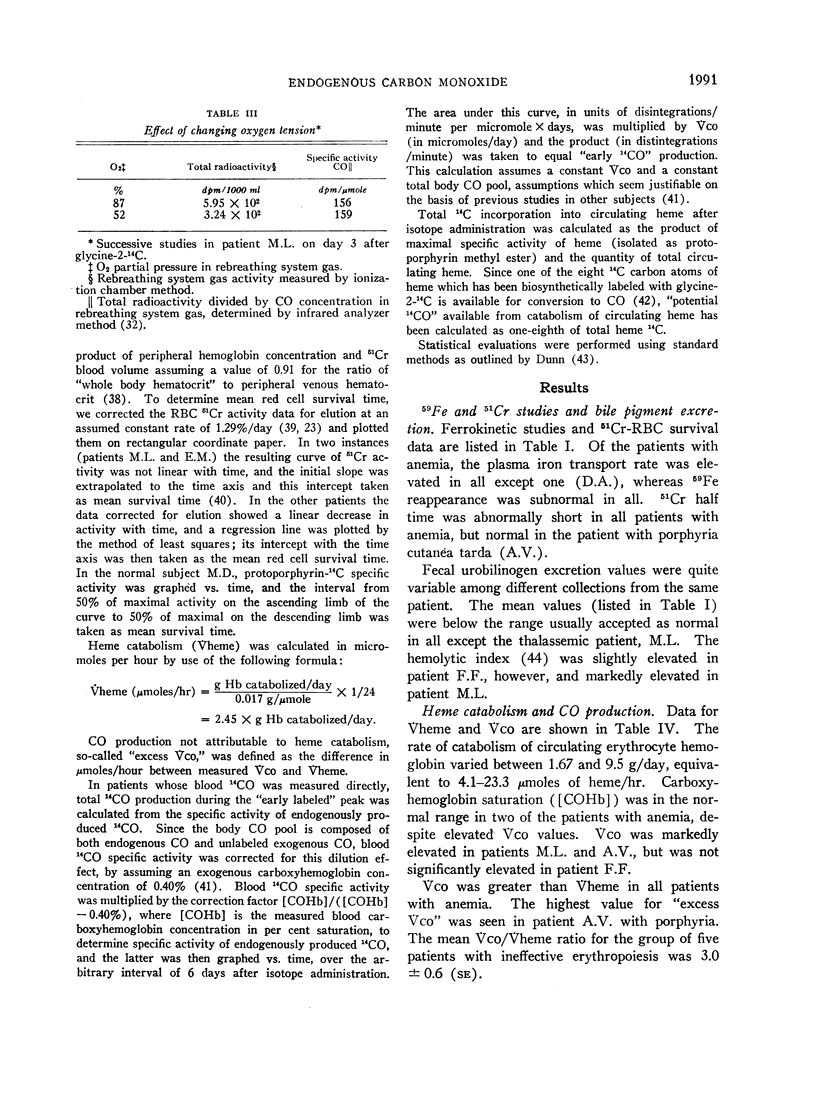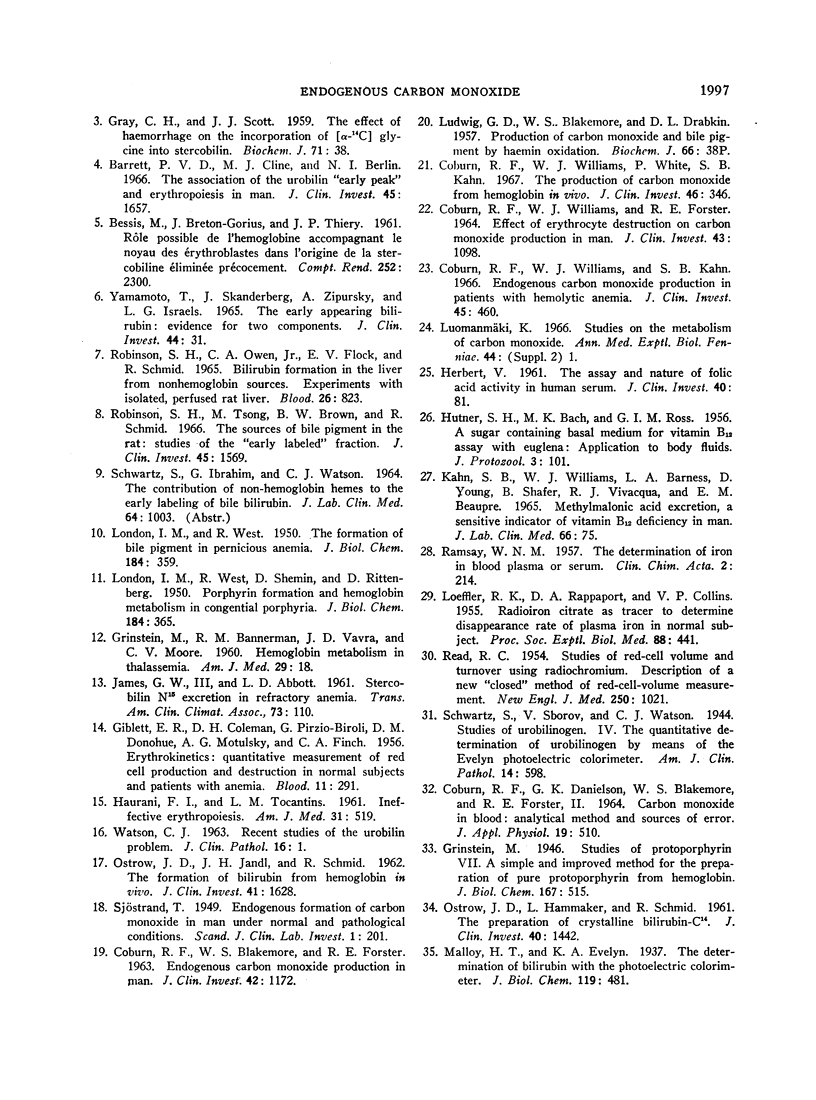Abstract
The rate of endogenous carbon monoxide production (˙Vco), determined by the closed rebreathing system technique, was elevated above the normal range in four of five patients studied with ineffective erythropoiesis (four patients with primary refractory anemia, one with thalassemia). The mean molar ratio of ˙Vco to ˙Vheme (rate of circulating heme catabolism, determined from 51Cr red cell survival curves) was 3.0 ± 0.6 (SE), indicating that most of the CO originated from sources other than circulating erythrocyte hemoglobin, in contrast to previous findings in patients with hemolytic anemia, where ˙Vco paralleled ˙Vheme closely.
After administration of glycine-2-14C to these patients, endogenous CO was isolated by washout of body CO stores at high pO2 or by reacting peripheral venous blood samples with ferricyanide. The CO was then oxidized to CO2 by palladium chloride and trapped for counting in a liquid scintillation spectrometer. “Early labeled” peaks of 14CO were demonstrated which paralleled “early labeled” peaks of stercobilin and preceded maximal labeling of circulating heme. Production of “early labeled” 14CO in patients with ineffective erythropoiesis was greatly increased, up to 14 times that found in a normal subject.
The increased ˙Vco and “early 14CO” production shown by these patients are presumably related mainly to heme catabolism in the marrow. The possibility exists that hepatic heme and porphyrin compounds may also contribute significantly to ˙Vco, as suggested by the finding of a high ˙Vco in an additional patient with porphyria cutanea tarda.
Full text
PDF












Selected References
These references are in PubMed. This may not be the complete list of references from this article.
- ALLEN T. H., ROOT W. S. Colorimetric determination of carbon monoxide in air by an improved palladium chloride method. J Biol Chem. 1955 Sep;216(1):309–317. [PubMed] [Google Scholar]
- Barrett P. V., Cline M. J., Berlin N. I. The association of the urobilin "early peak" and erythropoiesis in man. J Clin Invest. 1966 Nov;45(11):1657–1667. doi: 10.1172/JCI105473. [DOI] [PMC free article] [PubMed] [Google Scholar]
- CLINE M. J., BERLIN N. I. The red cell chromium elution rate in patients with some hematologic diseases. Blood. 1963 Jan;21:63–69. [PubMed] [Google Scholar]
- COBURN R. F., BLAKEMORE W. S., FORSTER R. E. Endogenous carbon monoxide production in man. J Clin Invest. 1963 Jul;42:1172–1178. doi: 10.1172/JCI104802. [DOI] [PMC free article] [PubMed] [Google Scholar]
- COBURN R. F., DANIELSON G. K., BLAKEMORE W. S., FORSTER R. E., 2nd CARBON MONOXIDE IN BLOOD: ANALYTICAL METHOD AND SOURCES OF ERROR. J Appl Physiol. 1964 May;19:510–515. doi: 10.1152/jappl.1964.19.3.510. [DOI] [PubMed] [Google Scholar]
- COBURN R. F., WILLIAMS W. J., FORSTER R. E. EFFECT OF ERYTHROCYTE DESTRUCTION ON CARBON MONOXIDE PRODUCTION IN MAN. J Clin Invest. 1964 Jun;43:1098–1103. doi: 10.1172/JCI104994. [DOI] [PMC free article] [PubMed] [Google Scholar]
- Coburn R. F., Forster R. E., Kane P. B. Considerations of the physiological variables that determine the blood carboxyhemoglobin concentration in man. J Clin Invest. 1965 Nov;44(11):1899–1910. doi: 10.1172/JCI105296. [DOI] [PMC free article] [PubMed] [Google Scholar]
- Coburn R. F., Williams W. J., Kahn S. B. Endogenous carbon monoxide production in patients with hemolytic anemia. J Clin Invest. 1966 Apr;45(4):460–468. doi: 10.1172/JCI105360. [DOI] [PMC free article] [PubMed] [Google Scholar]
- Coburn R. F., Williams W. J., White P., Kahn S. B. The production of carbon monoxide from hemoglobin in vivo. J Clin Invest. 1967 Mar;46(3):346–356. doi: 10.1172/JCI105536. [DOI] [PMC free article] [PubMed] [Google Scholar]
- DORNHORST A. C. The interpretation of red cell survival curves. Blood. 1951 Dec;6(12):1284–1292. [PubMed] [Google Scholar]
- GIBLETT E. R., COLEMAN D. H., PIRZIOBIROLI G., DONOHUE D. M., MOTULSKY A. G., FINCH C. A. Erythrokinetics: quantitative measurements of red cell production and destruction in normal subjects and patients with anemia. Blood. 1956 Apr;11(4):291–309. [PubMed] [Google Scholar]
- GRAY C. H., NEUBERGER A., SNEATH P. H. A. Studies in congenital porphyria. 2. Incorporation of 15N in the stercobilin in the normal and in the porphyric. Biochem J. 1950 Jun-Jul;47(1):87–92. doi: 10.1042/bj0470087. [DOI] [PMC free article] [PubMed] [Google Scholar]
- GRAY C. H., SCOTT J. J. The effect of haemorrhage on the incorporation of [alpha-14C]Glycine into stercobilin. Biochem J. 1959 Jan;71(1):38–42. doi: 10.1042/bj0710038. [DOI] [PMC free article] [PubMed] [Google Scholar]
- GRINSTEIN M., BANNERMAN R. M., VAVRA J. D., MOORE C. V. Hemoglobin metabolism in thalassemia. In vivo studies. Am J Med. 1960 Jul;29:18–32. doi: 10.1016/0002-9343(60)90004-8. [DOI] [PubMed] [Google Scholar]
- HAURANI F. I., TOCANTINS L. M. Ineffective erythropoiesis. Am J Med. 1961 Oct;31:519–531. doi: 10.1016/0002-9343(61)90136-x. [DOI] [PubMed] [Google Scholar]
- HERBERT V. The assay and nature of folic acid activity in human serum. J Clin Invest. 1961 Jan;40:81–91. doi: 10.1172/JCI104240. [DOI] [PMC free article] [PubMed] [Google Scholar]
- JAMES G. W., 3rd, ABBOTT L. D., Jr Erythrocyte destruction in sickle-cell anemia: simultaneous N15-hemin and N15-stercobilin studies. Proc Soc Exp Biol Med. 1955 Mar;88(3):398–402. doi: 10.3181/00379727-88-21599. [DOI] [PubMed] [Google Scholar]
- JAMES G. W., 3rd, ABBOTT L. D., Jr Stercobilin N15 excretion in refractory anemia. Trans Am Clin Climatol Assoc. 1961;73:110–120. [PMC free article] [PubMed] [Google Scholar]
- LOEFFLER R. K., RAPPOPORT D. A., COLLINS V. P. Radioiron citrate as tracer to determine disappearance rate of plasma iron in normal subjects. Proc Soc Exp Biol Med. 1955 Mar;88(3):441–444. doi: 10.3181/00379727-88-21612. [DOI] [PubMed] [Google Scholar]
- LONDON I. M. The conversion of hematin to bile pigment. J Biol Chem. 1950 May;184(1):373–376. [PubMed] [Google Scholar]
- LONDON I. M., WEST R., SHEMIN D., RITTENBERG D. On the origin of bile pigment in normal man. J Biol Chem. 1950 May;184(1):351–358. [PubMed] [Google Scholar]
- LONDON I. M., WEST R., SHEMIN D., RITTENBERG D. Porphyrin formation and hemoglobin metabolism in congenital porphyria. J Biol Chem. 1950 May;184(1):365–371. [PubMed] [Google Scholar]
- LONDON I. M., WEST R. The formation of bile pigment in pernicious anemia. J Biol Chem. 1950 May;184(1):359–364. [PubMed] [Google Scholar]
- LOWRY P. T., HAWKINSON V., WATSON C. J. An isotopic study of type III porphyrins and hemoglobin metabolism in an unusual case of "mixed" porphyria. Metabolism. 1952 Mar;1(2):149–154. [PubMed] [Google Scholar]
- Landaw S. A., Winchell H. S. Endogenous production of carbon-14 labeled carbon monoxide: an in vivo technique for the study of heme catabolism. J Nucl Med. 1966 Sep;7(9):696–707. [PubMed] [Google Scholar]
- NATHAN D. G., GABUZDA T. G., GARDNER F. H. LIQUID SCINTILLATION COUNTING OF C14-LABELED HEMOGLOBIN AND HEMIN BY A MODIFIED SCHOENIGER TECHNIQUE. J Lab Clin Med. 1963 Sep;62:511–516. [PubMed] [Google Scholar]
- NOMOF N., HOPPER J., Jr, BROWN E., SCOTT K., WENNESLAND R. Simultaneous determinations of the total volume of red blood cells by use of carbon monoxide and chromium in healthy and diseased human subjects. J Clin Invest. 1954 Oct;33(10):1382–1387. doi: 10.1172/JCI103015. [DOI] [PMC free article] [PubMed] [Google Scholar]
- OSTROW J. D., HAMMAKER L., SCHMID R. The preparation of crystalline bilirubin-C14. J Clin Invest. 1961 Aug;40:1442–1452. doi: 10.1172/JCI104375. [DOI] [PMC free article] [PubMed] [Google Scholar]
- OSTROW J. D., JANDL J. H., SCHMID R. The formation of bilirubin from hemoglobin in vivo. J Clin Invest. 1962 Aug;41:1628–1637. doi: 10.1172/JCI104620. [DOI] [PMC free article] [PubMed] [Google Scholar]
- Pass I. J., Schwartz S., Watson C. J. THE CONVERSION OF HEMATIN TO BILIRUBIN FOLLOWING INTRAVENOUS ADMINISTRATION IN HUMAN SUBJECTS. J Clin Invest. 1945 May;24(3):283–291. doi: 10.1172/JCI101604. [DOI] [PMC free article] [PubMed] [Google Scholar]
- RAMSAY W. N. The determination of iron in blood plasma or serum. Clin Chim Acta. 1957 Jun;2(3):214–220. doi: 10.1016/0009-8981(57)90105-5. [DOI] [PubMed] [Google Scholar]
- READ R. C. Studies of red-cell volume and turnover using radiochromium; description of a new closed method of red-cell volume measurement. N Engl J Med. 1954 Jun 17;250(24):1021–1027. doi: 10.1056/NEJM195406172502402. [DOI] [PubMed] [Google Scholar]
- REMMER H., MERKER H. J. EFFECT OF DRUGS ON THE FORMATION OF SMOOTH ENDOPLASMIC RETICULUM AND DRUG-METABOLIZING ENZYMES. Ann N Y Acad Sci. 1965 Mar 12;123:79–97. doi: 10.1111/j.1749-6632.1965.tb12247.x. [DOI] [PubMed] [Google Scholar]
- Robinson S. H., Owen C. A., Jr, Flock E. V., Schmid R. Bilirubin formation in the liver from nonhemoglobin sources. Experiments with isolated, perfused rat liver. Blood. 1965 Dec;26(6):823–829. [PubMed] [Google Scholar]
- Robinson S. H., Tsong M., Brown B. W., Schmid R. The sources of bile pigment in the rat: studies of the "early labeled" fraction. J Clin Invest. 1966 Oct;45(10):1569–1586. doi: 10.1172/JCI105463. [DOI] [PMC free article] [PubMed] [Google Scholar]
- SNYDER A. L., SCHMID R. THE CONVERSION OF HEMATIN TO BILE PIGMENT IN THE RAT. J Lab Clin Med. 1965 May;65:817–824. [PubMed] [Google Scholar]
- Schmid R., Marver H. S., Hammaker L. Enhanced formation of rapidly labelled bilirubin by phenobarbital: hepatic microsomal cytochromes as a possible source. Biochem Biophys Res Commun. 1966 Aug 12;24(3):319–328. doi: 10.1016/0006-291x(66)90158-6. [DOI] [PubMed] [Google Scholar]
- WATSON C. J. Recent studies of the urobilin problem. J Clin Pathol. 1963 Jan;16:1–11. doi: 10.1136/jcp.16.1.1. [DOI] [PMC free article] [PubMed] [Google Scholar]
- WITTENBERG J., SHEMIN D. The location in protoporphyrin of the carbon atoms derived from the alpha-carbon atom of glycine. J Biol Chem. 1950 Jul;185(1):103–116. [PubMed] [Google Scholar]
- YAMAMOTO T., SKANDERBEG J., ZIPURSKY A., ISRAELS L. G. THE EARLY APPEARING BILIRUBIN: EVIDENCE FOR TWO COMPONENTS. J Clin Invest. 1965 Jan;44:31–41. doi: 10.1172/JCI105124. [DOI] [PMC free article] [PubMed] [Google Scholar]


